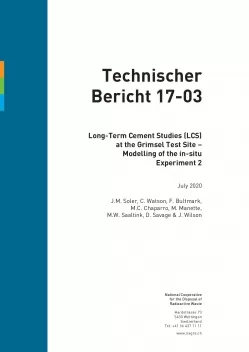
Technischer Bericht NTB 17-03
Long-Term Cement Studies (LCS) at the Grimsel Test Site – Modelling of the in-situ Experiment 2
Portland cement and concrete are major components of the engineered barrier system and of structural supports in different concepts for the geological disposal of low- and intermediate-level radioactive waste, high-level waste and spent fuel. The interaction between groundwater and cement causes the generation of hyperalkaline solutions (pH 12 – 13.5), which may react with the rocks hosting the repositories and may cause changes in their physical and chemical properties. Within the framework of the GTS-LCS project (Grimsel Test Site – Long-Term Cement Studies), a collaboration between JAEA (Japan), NAGRA (Switzerland), NUMO (Japan), POSIVA (Finland), RWM (UK) and SKB (Sweden), an in-situ experiment lasting about 6 years was started in 2009 at the Grimsel Test Site. The objective was the study of water-cement-rock interactions and their effect on water flow and solute transport properties under realistic flow conditions. Pre-hardened Ordinary Portland Cement cylindrical pieces were placed in a borehole intersecting fracture F16. Another two boreholes (observation and extraction boreholes) were placed at about 0.56 and 1.12 metres away from the emplacement borehole. Grimsel groundwater was circulated and injected in the emplacement borehole. Water was extracted at the observation and extraction boreholes and the chemical composition of the different solutions was monitored. Elevated pH and solute concentrations reflecting interaction with the cement were observed in the observation and extraction boreholes after injection was started in the emplacement borehole. Prior to and during the experiment, tracer tests were performed to characterise the flow and transport properties of the rock around the 3 experimental boreholes. Analyses of the cement and rock next to the emplacement borehole were performed at the end of the experiment.
Flow, tracer transport and reactive transport modelling of the in-situ experiment has been performed by different teams (SKB, IDAEA-CSIC/UPC (POSIVA), QUINTESSA (RWM)). The results from the different modelling exercises (tracer transport and reactive transport) have shown that it is possible to model and interpret the results of the in-situ experiment assuming either a homogeneous fracture or a fracture where flow is along preferential flow paths or channels. A real discrimination between the different flow models is not possible. Emphasis was put on the geochemical aspects of cement-groundwater-rock interaction and the main characteristics of the observed alteration of both cement and rock could be reproduced with the use of current thermodynamic and kinetic data (e.g. portlandite dissolution in the cement, calcite precipitation at the cement-gap and gap-rock interfaces, primary mineral dissolution in the rock, C-S-H/C-A-S-H precipitation in the rock), with improved results being obtained when using the most recent data for phases such as C-A-S-H. Finer details, such as the observed range in compositions of C-S H/C-A-S-H in the rock or the presence of minor amounts of CaCO3 precursor phases (aragonite, vaterite) could not be resolved in the modelling approaches used here. Overall, the understanding of the geochemical processes involved seems sound.
It is to be noted that the setup of the experiment was such that most information was obtained from the monitoring of solution composition at the 3 boreholes during the experiment, together with characterisation of the cement source and rock at the emplacement borehole at the end of the experiment. Therefore, while the main mineralogical and geochemical aspects of the alteration could be qualitatively reproduced, the calculated spatial extent and distribution pattern of alteration in the fracture were controlled by the implemented model concept (homogeneous fracture vs. discrete channels). Discrimination and further formulation of the concepts would depend on the characterisation of the flow field and of the mineralogical alteration in the fracture plane beyond the boreholes.
